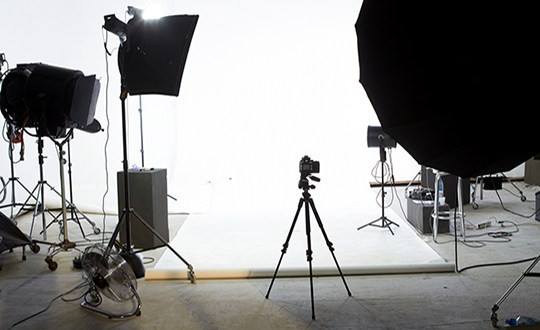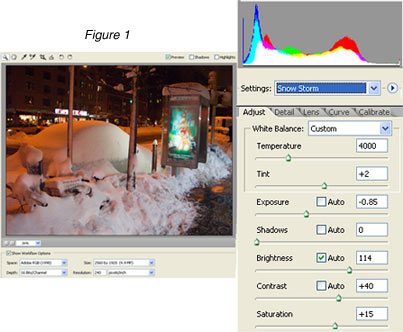Ella Manor's recent article presented some very exciting fashion images and, as that article discussed, her creative use of the Lensbaby tools added a great deal to the impact of the final photographs. However, she put a of work into setting up the project. It's not like you just pop on a Lensbaby, grab the first person walking down the street, and make such arresting photographs. We at NYIP asked Ella to backtrack a bit and offer people who might be inspired by this kind of work an idea of what kind of preparation is involved. We know you're going to like the article she's written.

Producing a photo shoot is an art form in its own right. Many times, especially when a photographer is starting out and is dealing with low budget productions or testing, the photographer is also the producer and the art director. Hell, when I started producing my own shoots, I was also the wardrobe stylist, make-up artist, hair stylist and sometimes even the model. But with some networking skills and a great portfolio, you can find yourself an entourage of talented professionals who will walk with you in fire and water.
So, how would you go about producing a fashion shoot like the one we produced for Creative Lenses Part 1: Lensbaby — where fantasies can come true?
Let's break it down and see the major factors.
Before we begin, take a look at this new Fashion Film from the same shoot:

To see the rest of the story in stills go to www.ellamanor.com.
The first thing you need when producing a fashion shoot is a vision. This vision can take on many forms. For example, it could be a narrative-a story you want to tell; or it could be a visual concept of colors, or textures, or mood, or composition.

An important aspect of having a vision before you start producing the shoot is imagining what type of lighting scenario you would like to create. This will greatly affect the mood and narrative of the story. In order to have a vision you must get inspired. Worry not, as finding inspiration is easy! All you have to do is look around you and experience your environment with an open heart and mind (and eyes).
If inspiration doesn't come that easily for you, rest assured you can always find it in other artists' work. Go to a book store or a magazine shop and start looking at work that you like or that is similar to your style. When you find the thing that lights up that creative spark in you, one that makes you feel like you want to do it yourself — then you have found your inspiration. Collect these pieces of inspiration and share with everyone you plan to involve in the project.

The next step is to research, contact, and book your team members. It is very important that you work with the right people. I can say beyond a doubt that the most important thing on the set is the atmosphere, and this is determined by the people you have selected. The energy that flies around between everybody on set is going to make or break the shoot, and as a result, the work itself.
When sourcing out talent please keep in mind these following Do's and Don'ts:
Do's
- Do select talent that has similar taste/style as you do.
- Do find talent that possesses a work ethic which is up to par with what you find adequate.
- Do source out a talent whose personality matches you own, one that you can get along with. In other words, you need to be able to communicate well with the people you work with .
Don'ts
- Don't select a wardrobe stylist without seeing examples of his or her work that you really love. Don't delude yourself into thinking that stylists will change their work for you or be able to create a different kind of work than what they have so far. Believe me, it rarely happens.
- Don't book people without meeting them in person first, when applicable.
- Don't reach out to a talent who doesn't have the required experience, equipment, contacts and attitude.

The first talent you are looking for when producing a fashion shoot is a wardrobe stylist. The wardrobe stylist's work is extremely important and vital to the success of the shoot. The stylist will contact the appropriate showrooms and designers to schedule appointments and select samples to borrow/pull for the shoot. They will then take the appointments, pick out the samples, and arrange for pick up and drop off dates. Next, you will seek out a make-up artist, hair stylist and nail technician. All play a very important role in producing the shoot and creating the final imagery. Again, make sure that these talents actually posses the talent, experience, and personality that you are seeking.
Now it's time to refer to your database and start contacting the appropriate individuals you have been connecting with on various social networks. There are many social networks for creative professionals on the Web who are looking for work and collaboration with other artists. This phenomenon is especially prominent in the fashion industry. If you are starting out and you still need to develop a network of creative talents, here are a few places to look:
- Model Mayhem (modelmayhem.com) — An online networking site for creatives in the fashion industry. MM accepts members who belong to one of these categories: photographer, designer, wardrobe stylist, make-up artist, hair stylist, model, body painter, photoshop wizard, filmmaker and casting director. In order to become a member you have to send MM a portfolio of work which shows your skills in the category you belong to. Once you are accepted, the best way to start virtually meeting other talents is to browse the system and start commenting on work that you like, sending friend requests and communicating about future work.
- The Behance Network (behance.net) — An online network for all sorts of creative individuals, not just fashion related. Some examples of the types of creatives you might find: illustrators, art directors, set designers, floral designers, photographers, web designers and photo illustrators. On Behance you can create portfolios to showcase your work, search for jobs, connect with other creatives, and easily promote your work by linking your account with Twitter, Facebook, and LinkedIn.
- LinkedIn — "Re-connect, power your career and get answers". These are the three goals LinkedIn stands for. LinkedIn is not just for the creative professional, it is for professionals from all industries. Among many features, the great things about LinkedIn are the extremely organized, visually appealing public profile you can build, the fact that you can recommend people and get recommended, and the possibility of seeing who viewed your profile, getting introduced by other mutual acquaintances, and you can join groups in your area of interest.
- Facebook — Everyone knows Facebook by now, but not everyone knows it could be used as a great professional tool to get work, network potential future team members, and showcase your work and get feedback. Whether you create a "Like" page or just stick to the regular profile page, it would be wise to take advantage of the tremendous amount of people who are up on this network.
Now that we have established how to find people we can collaborate with to create beautiful imagery, it's time to get to work. Now you need to decide on the following factors:
- Location — Are you shooting in the studio or on location? If shooting on location, ask yourself, "Where will the makeup and hair be done? Where will the model change? Do I have a plan B in case it rains or it's too hot and humid? Do I need permits, etc? "
- Camera and lighting equipment — Are you buying new equipment or renting? If you are renting, you might consider reserving the equipment for the date you need.
- Transportation — Make sure everyone knows how to get to the location and that they have a safe way to arrive. If the shoot ends late, you have to make sure to get your team members and models safely back to their homes.
- Food — Make sure there is food and drinks for everyone during the shoot. If everyone is taking care of their own meals, it is your responsibility to get food for the models.

Finally, the day of shoot arrives; you are on your own now to manage your team and make sure their needs are taken care of. Make sure you take a few minutes with each team member to discuss what they are going to do. Also make sure to greet everyone, introduce them to the rest of the team members, and most importantly, make sure to have fun and be creative!






